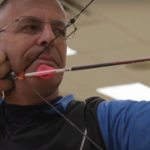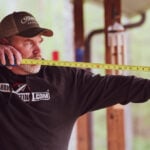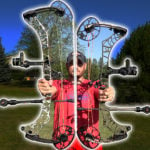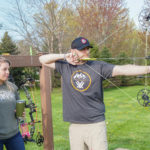Target Panic, in its purist sense, is a form of shot anticipation. The archer tries to command the shot at the exact moment the sight pin rolls onto the target. Some individuals can shoot reasonably well using this technique.
Eventually though, if left unchecked, this procedure will morph itself into a crippling disorder that will soon become a nearly indestructible routine. Breaking this habit is comparable to smashing a brick with a rubber hammer. It’s real hard, and it isn’t going to happen quickly. The first step to fixing the problem is admitting that there is one.
The Right Release
The most accurate way to launch an arrow is subconsciously. It should be as simple as walking across the room and should occur as an utter surprise.
But how? Many bowhunters do not learn to shoot a bow in that manner so the very thought of sending an arrow down range without thinking about it seems unimaginable to many. However, if self-doubt is pushed aside a new method for shooting can be learned.
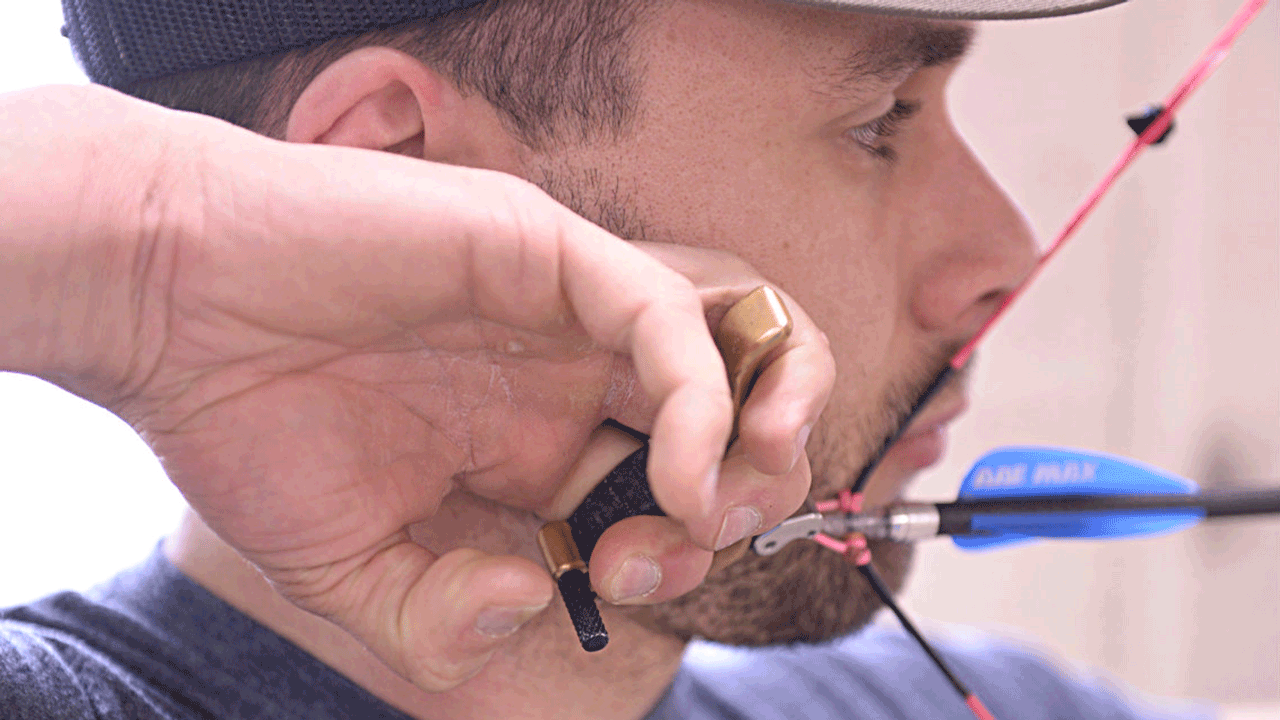
A change in the release aid is the first step. The manner in which the bow is “aimed” is the second. After acquiring a release aid that does not permit the shooter to “punch” the trigger, the process can begin.
Many shooters opt for back-tension style release but any release aid that doesn’t allow the shooter to punch the trigger will suffice. There are several great back tension releases on the market to pick from so find one that matches your style of shooting.
A popular model for bowhunters is the SCOTT Little Bitty Goose Deluxe. This particular model comes with 3 different types of trigger posts; a slim line trigger post, medium size knurled trigger post and spring trigger post.
For the purpose of curing target panic the spring trigger post should be utilized. This essential prevents the shooter from “punching” the trigger. When “punching” is attempted, the spring simply bends and the release-aid does not work.
However, when the spring is pull slowly the release works as it normally would and cuts the shot. Another advantage to using this release is that once hunting season arrives there is no need to switch release-aids. This release can be used for both shot training and hunting.
If desired, the spring can be replaced with a standard trigger post. By then, hopefully, the new shooting process will be engrained in the subconscious and the spring will no longer be needed.
The Process of Blank Bailing
Start out by shooting at a blank target. Standing no more than 4-5 feet away from the target, draw the bow and aim at the center of the target face. Upon reaching your anchor point, make sure that the arrow is indeed going to hit the target.
If so, close your eyes. With nothing to look at or distract your attention, you are now ready to execute the shot. Place your finger on the release-aid trigger and slowly begin squeezing; relying solely on your senses to cut the shot.
This will feel intimidating at first. Typically, the body and mind will fight the impulse to hammer the trigger. Thankfully, the release aid will not allow this to happen. It may take several days before the process becomes comfortable and arrows are fired on a consistent basis.
However, every time the process is repeated the subconscious will be rewiring the way the shot is triggered. After hundreds of attempts (more or less), it will gradually start to become a habit.
After three weeks, it will be time to open your eyes and begin shooting at real targets again.
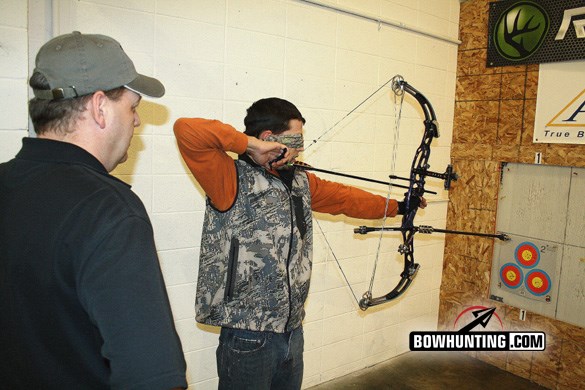
Try using a realistic target; like a 3D target. When aiming at the target the conscious mind will struggle to just let the pin float around the spot you want to hit. At times it will drift back to the trigger finger and what it is doing.
Most shooters will try to hold the sight pin as steady as possible. This is a mistake. The mind can only concentrate on one thing at a time. If you attempt to concentrate on two different things at once you will fail to fully concentrate on either.
It is important to understand that aiming isn’t about actually aiming at anything at all. At least not with the sight pin. Instead, you must learn to aim with your eyes. In other words, you must learn to focus all of your conscious thought on the spot you want to hit, while (most importantly) the subconscious mind activates the shot.
It is two entirely different actions that must happen in unison. We all possess a self-centering mechanism that will center the sight pin on the target. We simply must trust it to do its job, and not fight it for control of the pin.
Consider this point. As long as the conscious mind is thinking about what the trigger finger is doing, you are no longer aiming. And if you aren’t aiming, how could you expect to hit anything? Eventually it should become evident that aiming isn’t about holding the pin dead-steady and it isn’t about smashing the trigger the instant the sight pin is on the mark.
Aiming should essentially be the process of burning a hole on the spot you want to strike, while your pin floats around it. The pin may hover on or off the spot. It may drift above or below the spot. It doesn’t matter. As long as you never remove your conscious focus from the aiming point, and let your subconscious trigger the shot, phenomenal things will happen.
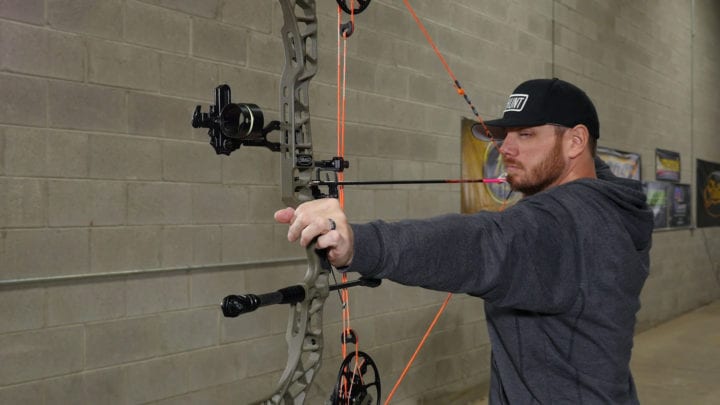
After shooting this way for a while you should learn to just let the sight pin float naturally around the aiming spot. In essence, all that must be done is to put it in the general area and “forget about it” because natural movement of the sight pin is vital to success.
Triggering The Shot
Using the back muscles, in order to trigger the shot, is also an essential element of the total shot sequence. Instead of solely squeezing the trigger with the index finger, learn to pull through the shot using the muscles in my upper back on the release hand side of the body. This will make shooting accuracy even better.
Think of it as trying to draw the shoulder toward the spine. It is also important to note the position of the trigger in relation to the trigger finger. The trigger itself should rest deep within the finger, between the first and second knuckle. As a result, the finger then becomes somewhat of a hook. As you pull with your back, your finger begins to apply pressure to the trigger.
Eventually the tension builds and the trigger breaks, releasing the arrow via complete surprise. After a while you may opt for the trigger finger to do less squeezing and act solely as a hook, while the upper back muscles work to cut the shot. It is imperative to experiment with the trigger travel as well as trigger pull until the best combination is found.
Too much travel and your mind will lose focus on aiming. Too light of a trigger and you won’t be able to “hook up” with your trigger finger without setting release off and firing the bow. You can pull through the shot with your back or simply squeeze the trigger until the release fires. Either way is adequate.
However, a combination of both is even better. Pulling through the shot, using only my back muscles, certainly helps establish good follow through habits that are vital to improving accuracy, especially at extended ranges.
Conclusion
There are many facets to this demon called Target Panic, and just as many cures. It takes time, patience, and above all, dedication. Stay the course and don’t ever give up. It could be the hardest thing you ever do, but also, the most rewarding. Remember, in spite of what other‘s may say, this condition is real.
It will not go away in the same manner in which it came. It takes work, a lot of work. It also takes a personal commitment. You have to need it. Simply “wanting it” will not bring you the results you are looking for.
It helps to locate someone who has been there and done that. It may be your neighbor, someone at the local pro shop, or a complete stranger you will never meet. Again, there are just as many ways of purging your system of this affliction as there are Long Horns in Texas. This is but one. Find the one that best suits you.

 By
By 